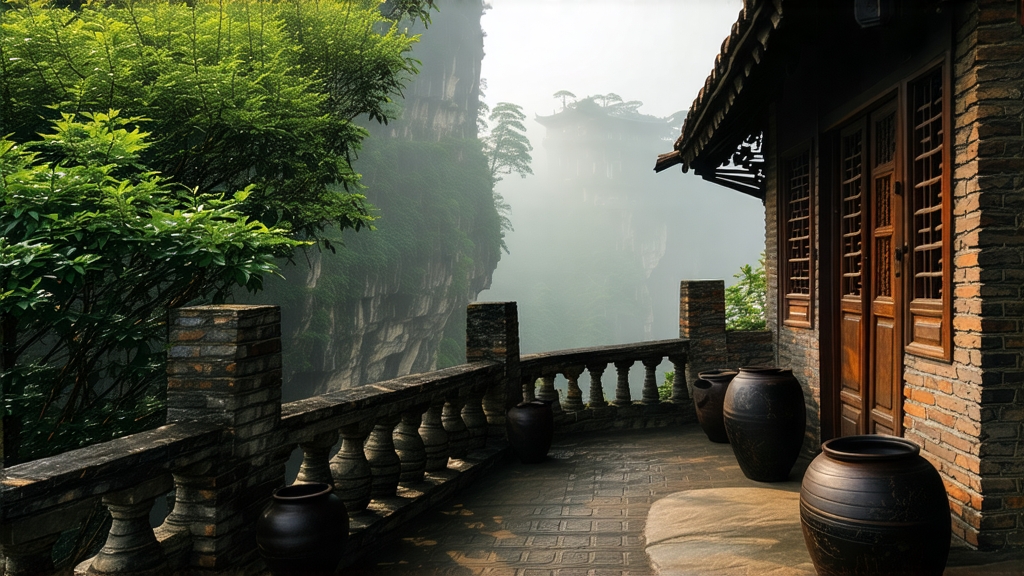
If green tea is China’s liquid spring and pu-erh its earthy autumn, then Da Hong Pao—Big Red Robe—occupies the imperial throne of Chinese oolong, reigning from the vertiginous Wuyi Mountains in northern Fujian. International drinkers often meet oolong as a generic “half-fermented” tea, yet Da Hong Pao demands a separate passport: its leaves carry the scent of mineral cliffs, pine smoke, and orchid nectar in a single sip, a profile impossible to replicate beyond the 60-kilometre core scenic zone that UNESCO lists as both World Cultural and Natural Heritage. To understand why, one must climb the myth-laden gorges where tea bushes root directly into weathered igneous rock, sip the liquor monks once prescribed as “liquid meditation,” and learn why a 350-year-old legend still governs the price of 20 grams of leaf at auction.
Legend first. In the late Ming dynasty a scholarly candidate en route to the capital imperial exams fell violently ill at the foot of Wuyi’s Nine-Dragon Gorge. Monks from the nearby Tianxin Temple brewed leaves picked from nearby bushes; the scholar revived, passed the exams with top honours, and returned in jubilation, draping his crimson imperial robe over the tea bushes to honour their life-saving power. The name Da Hong Pao—literally “Big Red Robe”—was carved into the cliff face, and the six original bushes, still alive today, became known as the “mother trees.” Between 1998 and 2005 their annual harvest of less than 400 grams was gifted to foreign dignitaries; in 2005 the Chinese government declared them off-limits for commercial picking, ending the era of million-yuan-per-gram auctions and shifting attention to genetically verified clones cultivated from cuttings.
Botanically, Da Hong Pao belongs to the Wuyi qi zhong (“strange cultivar”) landrace, a diverse gene pool of over 200 named varieties adapted to thin, mineral-rich soils. The most prestigious modern Da Hong Pao is not a single-cultivar tea but a skillfully balanced blend—usually dominated by Qi Dan, Bei Dou, or Que She clones—each contributing layers of aroma, thickness, and lingering “rock rhyme” (yan yun), the elusive sensation of wet stone, cooling mint, and floral echo that connoisseurs swear can only originate from the Zheng Yan (“true cliff”) micro-terroir. Lesser teas grown outside the core protected zone are labeled Ban Yan (half-cliff) or Zhou Cha (river-flat), still excellent yet lacking the seismic depth of flavour that makes the original site the Burgundy of oolong.
Plucking begins in late April when the standard “open face” leaf—three to four half-mature leaves with a pronounced central vein—offers the ideal ratio of polyphenols to amino acids. Unlike green tea, tenderness is not the goal; the thicker blades withstand the rigorous shaking that follows. With sunrise, pickers climb bamboo ladders lashed to cliff ledges, filling wicker baskets strapped to their backs, then race downhill to the factory before noon heat wilts the leaf. What happens next is a 24-hour choreography of solar withering, indoor cooling, repeated tumbling in bamboo drums, and the critical “green-making” phase that defines Da Hong Pao’s soul. Masters call this yao qing—literally “shaking the green”—a mechanical bruising that ruptures cell edges, allowing enzymes to oxidise polyphenols while juices remain trapped inside. Done correctly, the leaf edges turn crimson while the centre stays emerald, creating the iconic “green leaf with red border” that signals 30–40 % oxidation, the sweet spot between green tea’s grassiness and black tea’s malt.
Once oxidation reaches the desired level, leaves are quickly pan-fired at 240 °C to halt enzyme activity, then rolled into the distinctive long, ribbon-like strips. The pivotal Wuyi twist comes next: two rounds of charcoal roasting inside shallow bamboo sieves set over a pit of glowing embers from local hardwoods. The first roast, 100 °C for two hours, drives residual moisture from the stem; after a month of rest the tea is re-roasted at 80 °C, then rested again. Some premium grades undergo a third, even gentler bake. Each cycle deepens the amber liquor, imparts notes of toasted nuts and smoked plum, and stabilises the leaf for decades of aging—yes, Da Hong Pao can mature like fine wine, developing medicinal cam